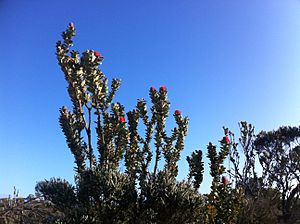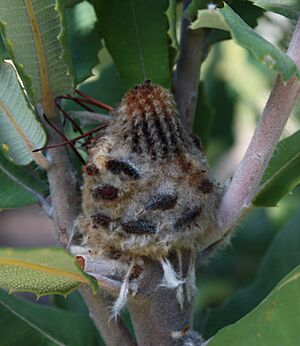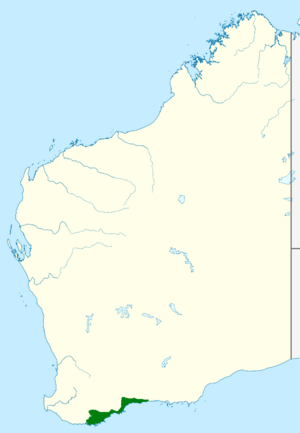Scarlet banksia facts for kids
Quick facts for kids Scarlet banksia |
|
|---|---|
 |
|
| Flower spike of B. coccinea Little Grove, Albany |
|
| Scientific classification | |
| Genus: |
Banksia
|
| Species: |
coccinea
|
| Synonyms | |
|
|
The Banksia coccinea, also known as the scarlet banksia, waratah banksia, or Albany banksia, is a type of shrub or small tree. It belongs to the plant family called Proteaceae. You can find it growing naturally along the southwest coast of Western Australia. Its home stretches from Denmark to the Stokes National Park, and north to the Stirling Range. It likes to grow in white or grey sand in areas with many shrubs, open woodlands, or heathlands.
This plant can grow up to 8 meters (about 26 feet) tall. It usually has one main stem. Its leaves are shaped like oblongs, about 3 to 9 centimeters (1 to 3.5 inches) long and 2 to 7 centimeters (0.8 to 2.8 inches) wide. The bright red and white flower spikes mostly appear in the spring. As the flowers get older, they form small seed pods called follicles. These pods keep the seeds safe until a bushfire opens them up. Even though it grows in many places, the scarlet banksia is very sensitive to a plant disease called dieback. This disease has sadly killed many plants.
Robert Brown collected and described the scarlet banksia in the early 1800s. It seems to be most closely related to Banksia speciosa and B. baxteri. Scarlet banksia plants are killed by bushfires. After a fire, new plants grow from the seeds that were released. The flowers attract birds that eat nectar and insects, especially honeyeaters. Many different insects also visit the flowers. People think B. coccinea is one of the most beautiful Banksia species. It is a popular plant for gardens and is very important for the cut flower industry. It is grown in many countries, including Australia, South Africa, and the United States. When grown in gardens, B. coccinea likes sunny spots and soil that drains water well. However, it cannot survive in places with hot, wet summers.
Contents
What the Scarlet Banksia Looks Like
The scarlet banksia grows as a tall shrub or a small tree. It usually reaches about 2 to 4 meters (6.5 to 13 feet) tall. It does not spread out much to the sides. However, some plants can grow up to 8 meters (26 feet) tall, especially near Albany. The main trunk is usually single at the bottom before it branches out. It has smooth, grey bark that is 2 to 5 millimeters (0.08 to 0.2 inches) thick.
New growth on the plant is pinkish-brown and very hairy. This new growth appears mostly in the summer. The leaves are oblong, which means they are longer than they are wide. They are 3 to 9 centimeters (1 to 3.5 inches) long and 2 to 7 centimeters (0.8 to 2.8 inches) wide. They have small stems called petioles that are 3 to 5 millimeters (0.1 to 0.2 inches) long. The ends of the leaves are flat, and their edges are toothed, like a saw. These teeth are small, about 1 to 3 millimeters (0.04 to 0.12 inches) long.
When the leaves are young, their top surface is covered in fine fur. As they get older, they become smooth. The underside of the leaves is covered with white fur, especially along the middle vein.
Flower Spikes and Their Development
It takes a long time for the flowers to develop, about 9 to 12 months. The stems start to grow tiny flower parts in spring. But you won't see any flower buds for about five months after that. The flower spikes bloom from May to December or January, with the most flowers appearing between July and October.
These special flower clusters, called inflorescences, grow at the ends of branches that are one year old. They are short and round, about 3 to 6 centimeters (1.2 to 2.4 inches) high and 8 to 10 centimeters (3 to 4 inches) wide. One study found that each flower spike has about 286 individual flowers. The flowers are white and covered in grey or light brown fur. The long, thin part of the flower, called the style, is usually scarlet red. It can also be dark red, orange, or pink.
The flowers on all banksias grow in a spiral pattern around the flower spike. But on the scarlet banksia, they form clear vertical columns. These columns are very noticeable because there are large gaps between them. The red styles are paired in columns, and they stand out against the grey-white flowers, making a beautiful flower spike.
Seeds and Seedlings
The seed cluster, called an infructescence, is small. It has up to 20 small seed pods, or follicles, mostly at the bottom of the spike. Each follicle is about 6 to 8 millimeters (0.2 to 0.3 inches) long. They usually open up when there is a fire.
The seeds inside are 1.1 to 1.4 centimeters (0.4 to 0.5 inches) long. Each seed has a wedge-shaped body and a papery wing. One side of the seed is grey-black and wrinkled. The other side is black and shiny. The seeds are separated by a dark brown piece called a seed separator.
When a scarlet banksia seed sprouts, the first leaves that appear are called cotyledons. They are dull green and about 0.8 to 0.9 centimeters (0.3 inches) long. The stem of the seedling, called the hypocotyl, is thick and smooth. The first true leaves of the seedling are crowded together above the cotyledons. They are long and narrow with deeply toothed edges. As the plant grows, new leaves become more oval-shaped.
History and Naming
Discovery and How it Got its Name
The first known scarlet banksia plants were collected in December 1801. This happened when the ship HMS Investigator visited King George Sound. On board were the botanist Robert Brown, the artist Ferdinand Bauer, and the gardener Peter Good. They all collected plants.
Robert Brown officially described the species in his 1810 book, On the Proteaceae of Jussieu. He named it Banksia coccinea. The name coccinea comes from a Latin word meaning "scarlet." This refers to the bright red styles (parts of the flower).
Other common names for the plant include scarlet banksia, waratah banksia, and Albany banksia. The Noongar people, who are the traditional owners of the land, call the tree Waddib.
Where the Scarlet Banksia Grows
The scarlet banksia grows close to the south coast of Western Australia. You can find it from the Hay River, northeast of Denmark and Albany, all the way east to Stokes National Park. It also grows inland to the Stirling Range and the northern edge of Fitzgerald River National Park.
About 47% of these plants are protected in special conservation areas. Another 13% grow along the sides of roads. The scarlet banksia prefers deep white or grey sand. It grows among tall shrubs, in heathlands, or in open woodlands. It is often found with other plants like Banksia baxteri, B. speciosa, and B. attenuata. In the Stirling Range and near Albany, it grows with trees like Eucalyptus marginata. Most of its habitat is gently rolling land. However, it can also be found on a steep, rocky slope at Ellen Peak in the Stirling Ranges. The area usually gets between 400 and 800 millimeters (16 to 31 inches) of rain each year.
Life Cycle and Threats

A study near Albany found that honey possums sometimes visit Banksia coccinea. Birds like the New Holland honeyeater, white-cheeked honeyeater, and western spinebill also visit the flowers. Bees, such as Hylaeus alcyoneus, also come to the flowers. The Carnaby's black cockatoo breaks off old seed cones to eat the seeds. They often do this before the seeds are fully ripe.
Reproduction and Fire
The scarlet banksia is killed by fire. After a fire, new plants grow from the seeds that are released from the burnt seed pods. The plant stores its seeds in the old flower spikes, which stay on the plant. However, it produces fewer seeds than other banksia species that grow in the same area. Unlike some other banksias, B. coccinea can release seeds and grow new seedlings even without a bushfire.
Plants start to flower and produce fruit three years after they sprout. They do not live as long as other banksias, often looking unhealthy or dying before they are 20 years old. This means they are well-suited to fires that happen more often, less than every 20 years.
Studies on cultivated plants showed that longer daylight hours (16 hours instead of 8 hours) led to more flower spikes. This suggests that the amount of daylight helps the flowers start to grow.
Threats and Diseases
Banksia coccinea is extremely sensitive to a plant disease called dieback. This disease is caused by a fungus-like organism called Phytophthora cinnamomi. The scarlet banksia is like an "indicator species" for this disease. This means if you see scarlet banksias dying, dieback is likely present. There is no known way to get rid of dieback once it's in an area. Much of the Stirling Range National Park is affected.
Applying a chemical called phosphite to affected areas can help. It reduces the number of plants that die to about 50%. B. coccinea can show some signs of being harmed by phosphite, like patchy dead spots on leaves. However, the plant does not absorb as much of the chemical as other shrubs.
In 1989, scientists noticed stands of B. coccinea dying. In 1995, they found a fungus called Cryptodiaporthe melanocraspedia was causing the problem. This disease, a type of aerial canker, first caused leaves and new growth tips to turn brown and die. Plants would die from the top downwards. Under the bark, orange and brown dead spots would spread from where the leaves join the stem. When these spots circled the stem, that part of the plant would die. Flower spikes could also be affected during blooming season. In warm, humid weather, white or pink spore threads would appear on the dead wood.
Another insect that affects B. coccinea is the gall midge Dasineura banksiae. This is a type of fly that lays its eggs on the leaves between late October and early December. The eggs cause round, white, hairy growths called galls to form on the leaves. These galls are 5 to 7 millimeters (0.2 to 0.3 inches) wide and usually contain one larva. While these galls do not harm the plant, they make the cut flowers look bad, which lowers their value.
Growing Scarlet Banksia
Many people consider B. coccinea one of the most beautiful Banksia species. It is a popular plant for gardens. It is also very important for the cut flower industry. It is grown for cut flowers in Australia, South Africa, Canada, the United States, New Zealand, and Israel. Its striking flower spikes and furry new growth are its main attractions for gardeners.
However, it is very sensitive to dieback disease and can die easily if exposed. It is hard to keep alive in places with heavy soils or with a lot of rain or humidity in the summer. This includes places like the east coast of Australia. Also, it might not flower much, or at all, when grown in warmer climates like Perth. Pruning the plant (cutting off branches) helps it grow more branches. More branches mean more flower spikes.
You can grow scarlet banksia from seeds. However, the seeds can be hard to get out of their pods. The seeds do not need any special treatment before you plant them. They usually sprout in 12 to 48 days. If you want to grow a specific type of B. coccinea (a cultivar), you need to use cuttings. This ensures the new plant is exactly like the parent plant. Cuttings can be slow to grow roots. Trying to graft B. coccinea (joining it to another plant's root system) has not been very successful.
At the University of Adelaide, a special breeding program developed two types of scarlet banksia. These were created mainly for the cut flower industry. Banksia 'Waite Flame' flowers early and has a somewhat orange color. B. 'Waite Crimson' has red flowers and blooms in the middle of the season.
See also
 In Spanish: Banksia escarlata para niños
In Spanish: Banksia escarlata para niños




